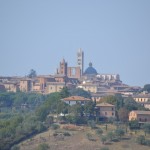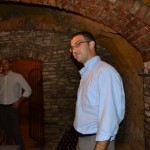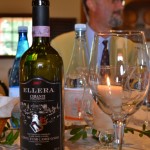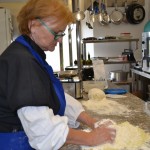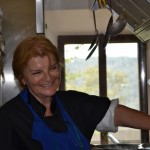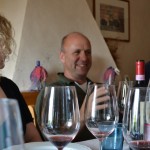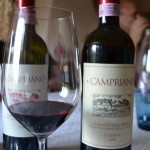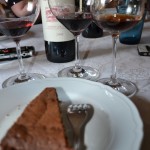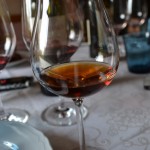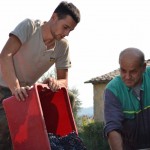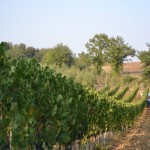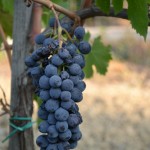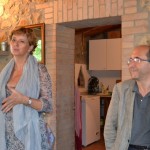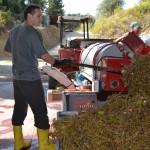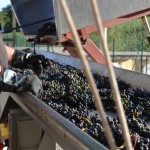There is Chianti; there is Chianti Classico (the area restricted to the historic or heartland of the region); and then there are Chianti’s seven subzones – Montalbano, Colli Fiorentini, Rufina, Colli Aretini, Colline Pisane, Montespertoli and Colli Senesi. A slice of the more general Chianti appellation, Chianti Colli Senesi has its own DOCG and adheres to stricter regulations that require lower yields (8,000 vs. 9,000). Within Colli Senesi there are three main areas, making up an 80 km stretch of land, located in the hills above the town of Siena.
Although Colli Senesi is the largest Chianti sub-appellation, compared to Chianti and Chianti Classico which produce 80 million and 23-28 million bottles annually, respectively, Colli Senesi is responsible for only 8 million bottles and is home to 500 producers. Since the subzone’s territory is also part of the larger Chianti area, producers within the delimited area can choose whether they will produce Chianti or Chianti Colli Senesi at the time of harvest.
The region has a long history of winemaking dating to the Etruscans who settled in Siena 2,500 years ago and began making wine. In 1716, Duke Cosimo I established the area, with the local wines further defined in 1841, when Ricasoli created the Chianti recipe. The original formula included, and in fact, required, a blend of both white and red grapes. While the white varieties are no longer part of the Chianti Classico regulations, they are still permitted in Colli Senesi and, if included, are used to mellow the tannins and set the color. Regardless of the producer’s choice of grapes, the wine must be comprised of at least 75% Sangiovese. Canaiolo, Colorino, Malvasia and Trebbiano, along with up to 10% Merlot and/or Cabernet Sauvignon, may supplement the blend, depending upon the winemaker’s philosophy.
While there is no specific taste profile to these wines that set them apart from other Chianti wines, the head of the Chianti Colli Senesi Consortio was adamant about stressing the reduced yields as a point of differentiation, higher quality, and clearly, pride. Accordingly, at least in theory, these wines should be of a higher quality than basic Chianti.
As elsewhere, each vintage brings its own set of challenges and harvest 2011 did not disappoint in that regard. Typically, the Chianti Colli Senesi area experiences a decrease in heat on or around August 15, but, this year, Mother Nature had other plans. Instead of cooler temperatures, the remainder of August and into September was quite hot.
Consequently, grapes raisined on the vine in the intensity providing good conditions for vin santo, but requiring a quick response to harvest grapes for the dry whites. It also meant that everything was in full swing when we visited in the last week of September.
Our arrival in the midst of harvest activities gave us the opportunity to catch mechanical harvesters, sorting tables and crusher/destemmers in action. We watched as grapes were loaded into the machines which quickly spit out stems, getting the grapes ready for the next stage in the process toward becoming wine. The heavenly scent of fermenting grapes followed us everywhere, but kept us out of a few cellars for safety.
Moreover, we were invited to participate in a traditional dinner, which celebrates the harvest and brings all of the field workers together, at Fattoria Campopalazzi. The working farm property at Fattoria Campopalazzi is presided over by Anna Maria Di Rienzo, a PhD-trained scientist, who has harnessed her scientific knowledge and put it to work at the winery. Anna Maria and her husband graciously received our group on our third evening, providing us with a brief tour of the winery and the rooms she rents out as a bed and breakfast.
We were then led to an arbored patio where we toasted the harvest with her employees and feasted on bread, salami, cheeses, olives and other assorted fare. Little did we know that this was only the aperitif. Moving to a room upstairs in the farm house, we somehow found room to consume a full dinner and taste through several wines.
At dinner, we were joined by Anna Maria’s consulting winemaker from Fattoria Montepescini, which we had visited earlier in the day. This winery is located in the village of Montepescini, which is home to less than 30 inhabitants.
Another stop took us to Castel di Pugna, named for a nearby battle in which Siena triumphed over the Florentines back in the 1200s. Today, the property is owned by Count Carlo Alberto Fumi Cambi Gado and his son, Luigi Alberto. The castle itself dates to 1259 and their historic cellar is carved out underground from the tufa soil. Production for their four wines is limited to 14ha of estate grown fruit, all of which is hand-harvested. We were provided with a beautiful luncheon at which we tasted their basic Chianti Colli Senesi, the Riserva and a Supertuscan called Castelpugna.
At Campriano, we were greeted by owner, Ranuccio Neri, who explained that his newer plantings focus on higher densities and lower yields. Ranuccio’s chef, Roberta, gave us a lesson on the art of making gnocchi, while he gave us a primer on recent vintages, noting that 2007 was a hot year, while 2006 and 2008 were more moderate, with 2006 being better than 2008.
Our host further acknowledged that 2001 had been a particularly good year, providing excellent growing conditions. Not surprisingly, he produced a Riserva wine that year, which was showing beautifully that afternoon. To qualify as Riserva, the wine must possess a full degree higher of alcohol (11.5% vs. 12.5% abv for Riserva) and be aged in a combination of wood and bottle for a minimum of one year.
Ranuccio invited us for lunch at his property, at which we enjoyed the fruits (or, perhaps, more correctly the pasta) of our labor and tasted through several different vintages of Campriano wine. We concluded the meal with a chocolate tart and a glass of Ranuccio’s vin santo, which was, hands-down, the group’s favorite vin santo of the entire trip. It was truly a perfect ending to the meal.
TASTING NOTES
Montepescini, Chianti Colli Senesi 2010, Tuscany, Italy
Tasted from a barrel sample, this wine displayed black cherry and floral notes on both the nose and palate. The firm tannins need some time to soften.
Bindi Sergardi, Chianti Colli Senesi 2009, Tuscany, Italy
This wine has aromas of floral, dried herbs and cherry. The richly layered palate offered vibrant acidity, ripe cherry and dried herb flavors and beautiful balance.
Campopalazzi, Chianti Colli Senesi 2008, Tuscany, Italy
This wine showed Sangiovese’s savory character with notes of tomato leaf as well as black cherry. On the palate, it had bright acidity, with cherry, tomato and dried herb flavors, along with dusty tannins.
Montalpruno, Chianti Colli Senesi Riserva 2007, Tuscany, Italy
Notes of sweet, red fruit and candy greeted the nose. On the palate, this wine showed vibrant acidity, with firm tannins (it needs some time) along with strawberry and cherry jam and an undercurrent of tropical fruit.
Castel di Pugna Ellera, Chianti Colli Senesi Riserva 2005, Tuscany, Italy
A blend of 95% Sangiovese and 5% Canaiolo Nero, this wine was aged for 24 months in oak barrels, with an additional six months of bottle aging before release. Herbal and red fruits dominated the nose and palate.
Campriano, Chianti Colli Senesi Riserva 2001, Tuscany, Italy
Despite its age, the wine’s color showed only a slight shift toward garnet. Vegetal and cherry notes greeted the nose and were joined by spice and herbs on the lively palate, culminating in long length.
Campriano, Vin Santo 2006, Tuscany, Italy
With its pronounced aromas of coffee, nuts, honey and caramel that persisted on the palate, this medium sweet wine had balanced acidity and long length.

